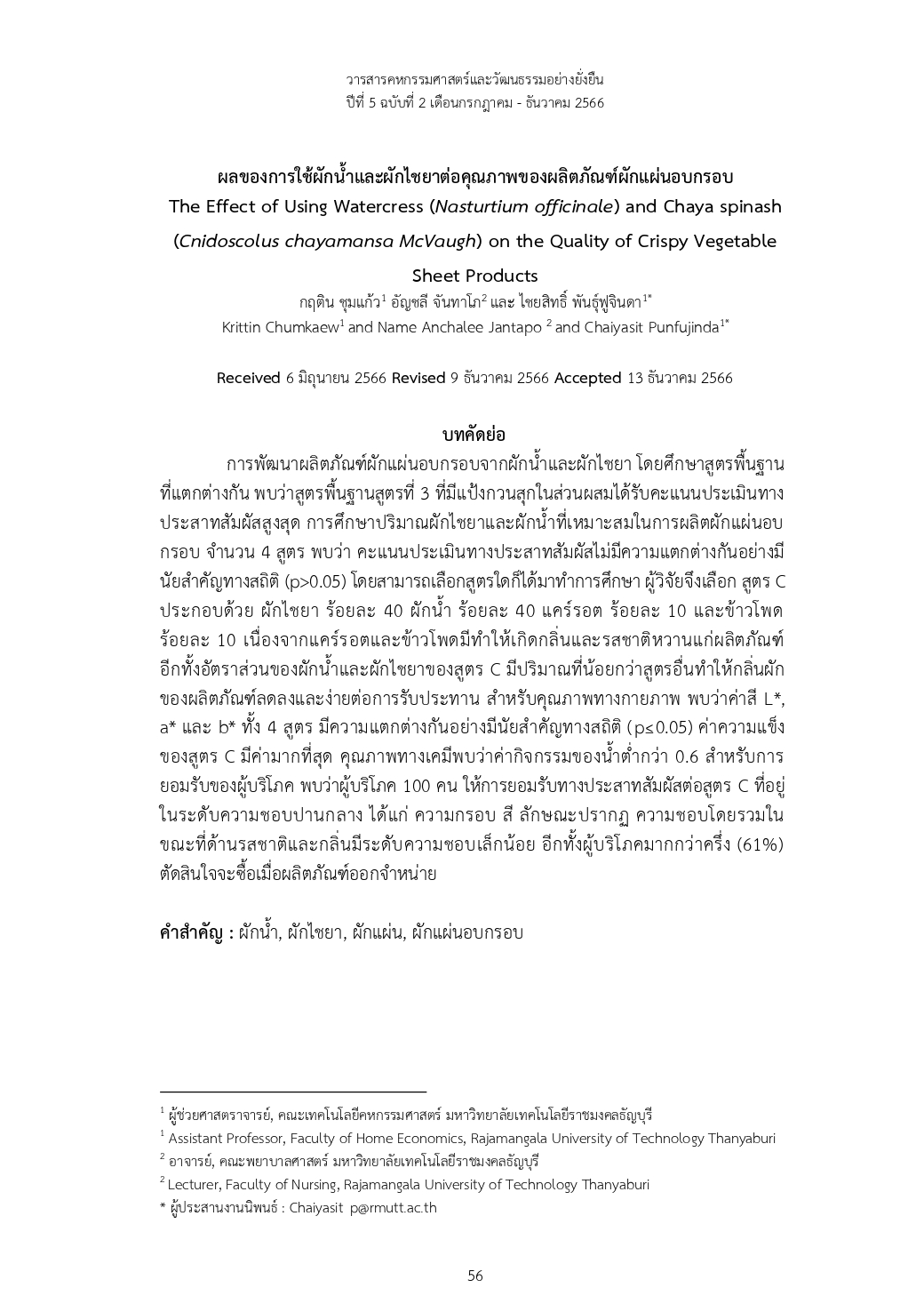The Effect of Using Watercress (Nasturtium officinale) and Chaya spinash (Cnidoscolus chayamansa McVaugh) on the Quality of Crispy Vegetable Sheet Products
Main Article Content
Abstract
The development of crispy vegetable sheets from watercress and Chaya spinash was studied, depending on the different basic formulas. It was found that formula 3 contained cooked flour in the ingredients and received the highest sensory evaluation score. A study of the appropriate amount of chaiya spinash and water vegetables for producing 4 recipes of crispy vegetable sheets found that the sensory evaluation scores were not significantly different (p > 0.05), making every recipe able to be selected for further research. Therefore, Formula C which consisted of 40% Chaiya spinash, 40% watercress, 10% carrots, and 10% corn was tokened. This is because carrots and corn have a sweet smell and taste to the product. In addition, the ratio of watercress and Chaiya spinash in Formula C is less than other formulas, causing the vegetable odor of the product to decrease and making it easier to consume. For the physical quality, the color values of L*, a*, and b* of the four formulas were significantly different (p≤0.05). The hardness value of formula C was the highest. For the chemical quality, the water activity value was below 0.6. The consumer acceptance test showed that the 100 consumers gave an acceptable score for sensory evaluation to the formula C at a moderate liking score, including crispness, color, appearance, and overall satisfaction, whereas taste and smell were at a slight liking score. Moreover, more than half (61%) of consumers decide to purchase when the product is released.
Article Details
References
กล้าณรงค์ ศรีรอต และเกื้อกูล ปิยะจอมขวัญ. (2550). เทคโนโลยีของแป้ง (พิมพ์ครั้งที่ 4). มหาวิทยาลัยเกษตรศาสตร์.
จิราภรณ์ แก่นท้าว, ธิดารัตน์ สีสด, และชุติมา ทองแก้ว. (2565, 11-12 กรกฎาคม). สาหร่ายเทียมจากใบไชยา [เอกสารนำเสนอ]. การประชุมวิชาการระดับชาติ มอบ. วิจัย ครั้งที่ 16, อุบลราชธานี, ประเทศไทย.
ปิลันธสุทธิ์ สุวรรณเลิศ. (2555). การพัฒนาผลิตภัณฑ์กะละแมอัญชัน. [วิทยานิพนธ์ปริญญาวิทยาศาสตรมหาบัณฑิต]. มหาวิทยาลัยราชภัฏเชียงใหม่.
ผกาวดี ภู่จันทร์, ไพรวัลย์ ประมัย, โสรัจวรชุม อินเกต, และอรุณลักษณ์ โชตินาครินทร์. (2565). การพัฒนาผลิตภัณฑ์ผักแผ่นอบกรอบ. วารสารวิชาการ มหาวิทยาลัยราชภัฏอุตรดิตถ์ สาขาวิทยาศาสตร์และเทคโนโลยี [เพื่อการพัฒนาท้องถิ่น], 18(1); 55-67.
เมตตา เถาว์ชาลี. (2562). ผลของ pH ที่มีต่อการย่อยสลายคลอโรฟิลล์และการหายไปของสีและระดับ กิจกรรมต้านอนุมูลอิสระในวอเตอร์เครส [เล่มรายงานการวิจัย]. สาขาวิชาเคมี คณะวิทยาศาสตร์และเทคโนโลยี มหาวิทยาลัยราชภัฏมหาสารคาม.
วันเพ็ญ แสงทองพินิจ, ศิริญา ทาคำ, พรทิพย์ เทพทับทิม, และปรีดา เฟื่องฟู. (2558, 30-31 มีนาคม). การพัฒนาผลิตภัณฑ์ผักแผ่นเพื่อสุขภาพจากกระเจี๊ยบเขียวและผักบุ้งจีน [เอกสารนำเสนอ]. การประชุมวิชาการระดับชาติมหาวิทยาลัยราชภัฏนครปฐม ครั้งที่ 7, นครปฐม, ประเทศไทย.
ศรีวิกรณ์ ดิษฐอุดมโพธิ์. (2548). การพัฒนาผลิตภัณฑ์ผักผลไม้แผ่น. สาขาวิชาวิทยาศาสตร์การอาหารและโภชนาการ ภาควิชาคหกรรมศาสตร์ คณะวิทยาศาสตร์ มหาวิทยาลัยศรีนครินทรวิโรฒ.
ศศิพินทุ์ ศุภมนตรี บัวพล, สมหญิง โควศวนนท์, และชุติมา ศิริกุลชยานนท์. (2564). ปัจจัยที่มีความสัมพันธ์กับปริมาณการบริโภคผักของนักเรียนชั้นประถมศึกษาตอนปลาย โรงเรียนสังกัดสำนักการศึกษาพื้นฐาน กรุงเทพมหานคร. วารสารวิทยาลัยพยาบาล พระจอมเกล้า จังหวัดเพชรบุรี, 4(3), 95-108.
ศิริบุญ พูลสวัสดิ์. (2544). การศึกษาความเปลี่ยนแปลงของค่าวอเตอร์แอกติวิตีในระหว่างการ เก็บผลไม้แห้ง. เอกสารผลงานที่เสนอประเมินเพื่อแต่งตั้งให้ดำรงตำแหน่ง นักวิทยาศาสตร์ 7 ว. กองวิทยาศาสตร์ชีวภาพ, กรมวิทยาศาสตร์บริการ, กระทรวงวิทยาศาสตร์ เทคโนโลยีและสิ่งแวดล้อม.
สำนักงานมาตรฐานผลิตภัณฑ์อุตสาหกรรม. (2554, 28 กันยายน). มาตรฐานผลิตภัณฑ์ชุมชนผักและผลไม้ทอดกรอบ. https://tcps.tisi.go.th/pub/tcps1038_54.pdf.
สิรินทร์ยา พูลเกิด. (2564, 27 เมษายน). ปัจจัยทางประชากรและสังคมที่มีอิทธิพลต่อการกินผักและผลไม้ไม่เพียงพอของคนไทย. https://www.theprachakorn.com/newsDetail.php?id=436.
อนุวัตร แจ้งชัด, สุจีบังอร เข็มทอง, สุกัญญา วงวาท, และรัชนีกร กิติศิริมงคล. (2548, 1-4 กุมภาพันธ์). การพัฒนาผลิตภัณฑ์ผักแผ่น [เอกสารนำเสนอ]. การประชุมทางวิชาการของมหาวิทยาลัยเกษตรศาสตร์ ครั้งที่ 43, กรุงเทพฯ, ประเทศไทย.
Punfujinda, C., Pattarathitiwat, P., Songpranam, P., Chitravimol, U., Buranasuont, R., & Chumkaew, K. (2021). Product Development of Sweet Fish Sauce from Dried White Shrimp: Sensory Evaluation, Physical and Chemical Quality and Nutrition. Journal of Food Health and Bioenvironmental Science, 14(3), 42-51.
Dholvitayakhun, A., Krisomros, J., Chantharasiri, P., Wutthichat, W., & Sanguanval, A. (2023). การพัฒนาผลิตภัณฑ์ผักแผ่นอบกรอบเสริมโปรตีนจากจิ้งหรีด. Rajamangala University of Technology Srivijaya Research Journal, 15(1), 60-73.
Kongphapa, J., Chupanit, P., Anutrakulchai, S., Cha’on, U., & Pasuwan, P. (2021). Nutritional and phytochemical properties of Chaya leaves (Cnidoscolus chayamansa Mc Vaugh) planted in Northeastern Thailand. Journal of Science and Technology, 27.
Kuti, J. O., & Kuti, H. O. (1999). Proximate composition and mineral content of two edible species of Cnidoscolus (tree spinach). Plant Foods for Human Nutrition, 53, 275-283.
Li, C. (2022). Recent progress in understanding starch gelatinization-An important property determining food quality. Carbohydrate Polymers, 119735.
Saencom S., Chiewchan N., & Devahastin, S. (2011). Production of dried ivy gounrd sheet as a health snack. Food and Bioproducts Processing, 89, 414-421.
Saengthongpinit, W., Thakham, S., Thepthubtim, P., & Fuangfoo, P. (2015). Development of Okra (Abelmoschus esculentus (L.) Moench) and Water Spinach (Ipomoea aquatica Var. reptans) Sheet as a Healthy Snack. In The 7th NPRU National Academic Conference. Nakhon Pathom Rajabhat University, Nakhon Pathom, Thailand. (in Thai), (pp. 771-780).
SPSS. (2018). IBM SPSS Statistics 22 (Version 22) [Software]. Retrieved September 30, 2021, from http://www.spss.com.hk/.
Swapna, G., Jadesha, G., & Mahadevu, P. (2020). Sweet corn–a future healthy human nutrition food. Int. J. Curr. Microbiol. App. Sci, 9(7), 3859-65.
Wang, S., & Copeland, L. (2013). Molecular disassembly of starch granules during gelatinization and its effect on starch digestibility: a review. Food & function, 4(11), 1564-1580.
Wongpaisanrit, R., & Pongsankeeree, W. (2020). ฤทธิ์การต้านอนุมูลอิสระของน้ำนมข้าวโพดสามสายพันธุ์. RMUTP Research Journal, 14(2), 152-159.
Xiao, Y., Xie, L., Li, Y., Li, C., Yu, Y., Hu, J., & Li, G. (2023). Impact of low temperature on the chemical profile of sweet corn kernels during post-harvest storage. Food Chemistry, 431, 137079.


